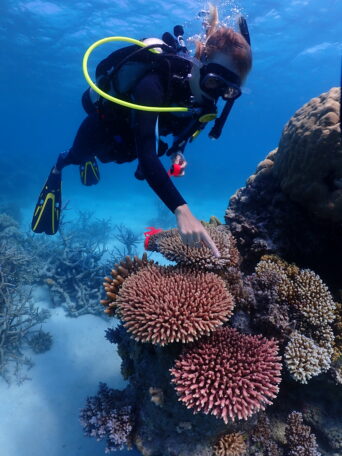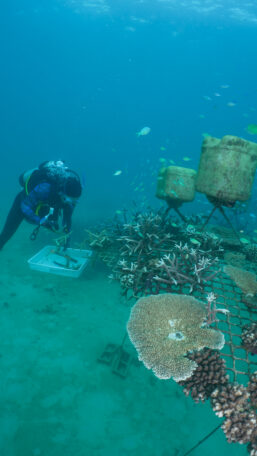Marine biologists John and Jenny Edmondson were so devastated by the mass coral bleaching that occured across the Great Barrier Reef (and the world) in 2016, that they came up with a cheap – and brilliant – plan to help restore the Reef to its glory.
The husband and wife, who are also co-owners of the Port Douglas-based Wavelength Reef Cruises, rallied other tourism operators to help build reef resilience simply by multi-tasking on their reef tours, and tending to coral nurseries while tourists enjoyed the wonders nearby.
Four years on and the program has delivered coral restoration at a scale never seen before on the Great Barrier Reef, with more than 70,000 coral fragments planted across 27 sites at an average 85 percent survival rate. Almost 50,000 of these fragments were planted by the Edmondson’s Wavelength Reef Cruises crew.

Funded by the partnership between the Australian Government’s Reef Trust and the Great Barrier Reef Foundation, the program is a joint partnership between and the Port Douglas-based Wavelength Reef Cruises and University of Technology Sydney (UTS) scientists.
Lead UTS researcher and coral scientist, Professor David Suggett said the Coral Nurture Program was “an unprecedented success”.
“Some of the very first fragments that we planted at the end of 2018, the size of my finger, are now spawning by themselves after only three years,” he said. “This now means all the planting activity is able to start rehabilitating the reef on its own.
“That for us is a monumental milestone because it shows that reef replanting is working. It’s producing new reproductively-viable colonies that can then turn into seeding to create thousands of other colonies over time. It’s an absolute first as far as I know for this part of the world.”

The program has also given researchers some incredible learning outcomes that will feed into new stewardship-based management for the Great Barrier Reef. These include identifying crucial timeframes for handling fragments from the reef as well as material from the nurseries for planting so as to reduce stress and increase survivorship. They have also learned that certain bare areas are just not suited to planting.
“We often look for signs of high sediment deposition, evidence for farming damselfish, who like to knock the fragments out of their clips, and coral eating snails and starfish,” Professor Suggett said.
“Coral species-environment compatibility is also important of course and identifying substrates and or conditions (e.g. depth) that commonly favour specific taxa enables a more targeted approach.”
The program has even spawned its own innovation. The Coralclip®, invented by John Edmondson, is a device that attaches corals to the reef without the need for chemical bonding agents. The Coralclip® method is faster and cheaper than traditional out-planting methods and has contributed to high survival rates.

“The coral clip is just a simple little metal spring clip,” said John. “It’s nailed into the reef rock and a small coral fragment is placed under it. As long as that coral fragment stays still for around about six weeks, it will self attach to the reef and after a couple of years, it will look exactly like other coral colonies.”
“It’s not just about restoring local reef sites,” said John Edmondson. “In fact, restoration is a very small part of it…it is capacity building, which is increasing the number of operators and the number of crew that can help respond to future extreme weather events, and providing new expertise to the industry.”
Professor Suggett goes so far as to liken tourism operators to emergency crews.
“Immediately following storm damage, corals can break off and detach from the reef,” he said. “A lot of those will survive if they are replanted quickly. But there are strict permits to operating on the reef and a lot of procedures and training are needed to do that. The tourism operators are like first responders. They have all the training, expertise and local site knowledge to get the job done.”
“A viable tourism industry, with travellers booked on regular departures, is fundamental to the ongoing success of the program,” said Jenny Edmondson.
“Ultimately, we want visitors to come out, stick their heads underwater and see beautiful coral in its natural state — for them to experience the full beauty of the reef. Because once you see it, you’ll love it and there’s a greater chance you’ll become part of its future,” added John Edmondson.
The Coral Nurture Program also receives support from Reeftip Drinks Co. Ten per cent of Reeftip profits are contributed to the Coral Nurture Program which allows the team to continue their work to enhance coral recovery rates and reef regeneration.







